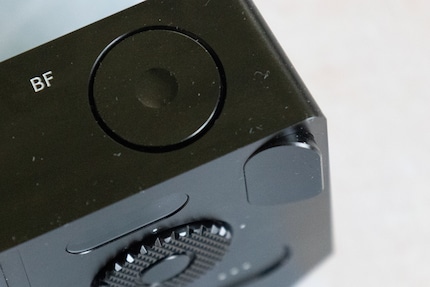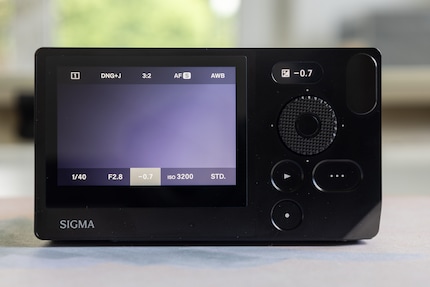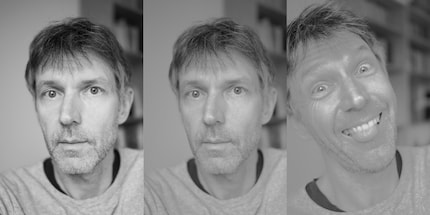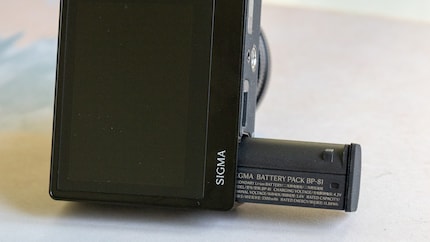

Sigma BF: less is not more
The radically slimmed-down design camera is intended to make photography easier. Sigma is doing some things right. But the omission of practical features does not make things any easier.
With the new BF camera, Sigma promises a reduction to the essentials. Elegant simplicity dominates its appearance and photography should also feel simple. The idea has something to it. Modern cameras are hyper-complex and look like it. That can be off-putting.
Be different at all costs
The Sigma BF doesn't even try to be ergonomic. It's a cold aluminium block with hard, uncomfortable edges. Even the mini-grip that your thumb is supposed to hold onto is made of metal. This is not an oversight, but a statement. There are just three buttons on the back next to a click dial. At the top is the shutter release. At the front, the button for changing the lens. Nothing else.

Connections: USB-C, nothing else. Memory cards: none. Image stabiliser: none. Viewfinder: none.
The Sigma BF is radically different. Even where it shouldn't be. This makes it interesting, but also takes some getting used to - to put it diplomatically.
The handling: surprisingly good
When I read the news about the new camera, I expected it to fail because of the operating concept. I know enough small digital cameras with few buttons and wheels from the noughties - and they all had the same problem: many settings were only accessible via a menu. Or they were missing altogether.
But the Sigma BF does it better. The control pad is also a rotary dial. The tiny second screen above it shows the active setting - exposure time, aperture, ISO, etc. Turn the wheel to change them. Tap left, right, up or down to change to a different setting. A total of ten settings are available - that's enough for normal use.

The main screen shows nothing but the viewfinder image - there are no overlays to distract from the subject search. You can still display the settings by clicking on the button in the dial - here you have the option of further options. Aperture, shutter speed and ISO can be individually set to automatic. This results in the camera modes P, A, S and M without you having to set them explicitly.
Clever: Automatically selected values light up less brightly on the second screen - so you can immediately see whether you can change a value or not. Another nice little feature: the two buttons for playback and menu can be touched as well as pressed. When touched, the playback button displays the last image taken. The system button shows how much battery you have, what time it is and how many more shots you can take until the memory is full.
Operation remains simple because there are not many settings. Reduction to the essentials.
Rethinking the autofocus
When it came to autofocus (AF), the minimalism really bothered me at first. I can either select a small single point or the entire viewfinder image as the AF point. There's nothing in between. The AF area is so small that the autofocus often doesn't work because there is too little contrast in the field. I can't enlarge it.
However, it turns out that I practically never need single-point AF. If I let the camera select the focus automatically, I can still tap an area on the touchscreen that I want to focus on. The camera activates object tracking and keeps the tapped area in focus when I move the camera. Object tracking is switched off again with a tap on a displayed button. This works very well.

If the camera automatically focuses on something unwanted, I can use the up and down arrow keys to jump to the next closer or more distant focus point. I think that's a good idea. However, I have to keep the shutter release button half-pressed, which means that I accidentally press it from time to time.
I can temporarily activate single-area AF by tapping the centre button with the shutter release button pressed halfway down. However, this also poses the problem of taking a photo unintentionally.
Finally, I can also set whether and for how long the focus magnifier should be displayed when the shutter release button is pressed halfway. This is because it is possible to refocus manually.
Once I have understood the concept, the autofocus is simple to use and still flexible enough for most situations. However, for someone like me, who gets on well with the autofocus of a complex camera, it is and remains a limitation.
Leave it out until it hurts
I search in vain for the viewfinder. There isn't one, not even as an optional accessory - the camera would have to have an accessory shoe for that.
Since the age of 45 at the latest, cameras without a viewfinder have been a no-go for me: I would have to wear reading glasses to see the screen clearly up close. But then I can no longer see clearly what there is to photograph. With a viewfinder, I can set the dioptres to farsightedness and see everything perfectly.
A viewfinder would also be practical in other respects, as it is easier to see in sunlight. The camera has a function to automatically adjust the screen brightness in sunlight. However, I don't see any difference whether the function is switched on or off.
But it's not just in sunlight that there are problems. If I want to take a photo of something close to the ground, I have to lie flat on the floor. Because the screen is immobile. If I want to film myself, I can't see whether I'm in the picture. There is also no app that would allow me to see the viewfinder image in such cases. There can't be because Wi-Fi and Bluetooth have been omitted like so many other things.
There is a remote cable release as an accessory. Via USB-C.
Image quality: good for such a small camera
The sensor has a resolution of 24 megapixels. This is relatively low for full format, but results in good noise behaviour at high ISO sensitivities. Especially as it is a back-illuminated sensor. Even at 51,200 ISO, a photo can be usable. This makes up a little for the lack of image stabilisation.
The dynamic range is difficult to judge without laboratory measurements. Sicher ist, dass die DNG-Dateien nur 12 Bit statt der heute üblichen 14 Bit aufweisen. Ob das im Alltag wirklich ein Nachteil ist, kann ich nicht sagen. Here you can see a backlit shot uncorrected, i.e. with the default settings of Adobe Lightroom and the same shot with depth and highlights corrected to the maximum. This gives an approximate impression of how much raw files can be corrected.
Image styles - nice, as long as you don't adjust anything
The Sigma BF offers 13 colour styles for videos and JPEG photos. 12 of these are in colour, one image style is monochrome. The colour styles are a matter of taste, I like many of them.
The styles can be customised: You can choose from the parameters Highlights and Shadows as well as Vignette and Fade. However, customising highlights and shadows leads to unusable results. In the following selfie, I only raised or lowered the two parameters by two out of five levels to achieve a softer image. Even with this small adjustment, the effect is too strong and unattractive (centre). With the settings turned up to the maximum (right), it is simply grotesque.

Excessive power guzzler
The battery has small dimensions, but holds 3300 mAh - a very good value. For comparison: the battery of a Canon EOS R5 has a capacity of 2130 mAh. Nevertheless, it does not last long with the Sigma BF. The CIPA value is a meagre 260 pictures. The Canon EOS R5 is much better off with 490 images, and the successor R5 II even has 630 images.
In everyday life, it feels like even less. The main reason for this is probably the poor standby function.
If I tap the on/off button briefly, the camera goes into standby mode. During this time, it displays the battery capacity in per cent on the small auxiliary screen - and I can watch this value drop. The camera must draw an enormous amount of power in standby mode. The camera can also be switched off completely by pressing and holding the button - then it takes over a second to switch on. Other cameras do this much better. They are also ready immediately when switched off and also require almost no power in standby mode.

SSD and USB connection
The Sigma BF has an internal SSD. According to Sigma, it has a capacity of 230 GB, but it is actually more like 250 GB. That's enough for 4300 RAW photos. Radical as the Sigma BF is, it only has an SSD, not a card slot.
In principle, internal memory in cameras is a great thing - I stand by this opinion, even though I was vehemently contradicted at the time. However, I also think that this memory should not be a replacement for removable cards, but a supplement. In other words, a backup or emergency memory in case the card is forgotten.
If the memory only consists of an SSD, various questions arise. Firstly, there is the question of longevity. If we assume that it is a triple-level cell SSD with 2000 write cycles, the SSD has a lifespan of 8.6 million RAW photos. That's definitely enough.
Nevertheless, an SSD can break at any time. I have asked the Sigma repair service whether it can be replaced in the event of a defect. The answer is still pending. Update: The SSD alone cannot be replaced, but the motherboard on which the SSD is located can. Depending on the time and circumstances, this may be a free warranty case or a fee may be charged.

The second question is about backups. Of course, the recordings can be transferred to a computer via USB, which is also very fast. However, I have to get the right USB 3.2 cable myself.
Alternatively, a card reader or other USB memory device can be connected to make a backup without a computer. However, photos can only be selected individually or by the day, and the transfer is surprisingly slow. The reason is unclear. I use a CFexpress card and a card reader from Angelbird, both of which are normally very fast.
Cloud backup is not possible as the camera has no internet connection.
Video: many compromises
The video function is activated when you choose between single image, continuous shooting or bracketing. And this roughly corresponds to the importance of video in this camera: It is one operating mode of many.
Without image stabilisation and a moving screen, the hardware does not offer good conditions for video. Electronic image stabilisation is available - with the usual crop. Of course, this less-is-more designer piece also lacks a headphone, microphone and HDMI port as well as an accessory shoe. Headphones can be used via the USB port with an adapter and supposedly a microphone can also be used (not tested). This is better than nothing, but no substitute for convenient connections.
The Sigma BF only manages 4K at 30 frames per second. However, it can also do 6K if you use H.265 or L-Log. With Full HD, the camera achieves 120 FPS, but in significantly reduced quality.
Face detection works, but I can't set the focus speed or sensitivity. The camera focuses quickly but reacts slowly. I think: either both slow or both fast. So it seems unbalanced.
The lens I used for this test is not designed for video and produces annoying autofocus noise. And with the Sigma BF, you'll normally be filming with the internal stereo microphone, which picks up these noises well.
In a nutshell
Unnecessary restrictions
Usually, cameras with few buttons and dials are cumbersome to operate. The Sigma BF is the first camera where this is not the case. I was pleasantly surprised in this respect.
Nevertheless, I feel that the camera does not fulfil its central promise. The reduction to the essentials is supposed to make photography easier. But a built-in image stabiliser, a movable screen or a viewfinder would not make photography any more complicated - on the contrary. This kind of reduction only puts obstacles in my way.
The image quality is fine. Unfortunately, the same cannot be said for the battery life. Even in standby mode, the battery drains surprisingly quickly. If you switch the camera off completely, it is not immediately ready for use.
The built-in SSD is a great thing. However, the fact that the USB port is the only interface and there isn't even Bluetooth or Wi-Fi falls into the category of "unnecessary restriction".
A camera can be a niche product and doesn't have to please everyone. However, even after testing the Sigma BF, it is still not clear to me who it might be suitable for.
Pro
- Built-in SSD
- Sophisticated operating concept
- Good image quality at high ISO
- Simple, but good autofocus
Contra
- Poor battery life
- no viewfinder
- No movable screen
- No image stabiliser
- No WLAN and Bluetooth
- Few setting options

My interest in IT and writing landed me in tech journalism early on (2000). I want to know how we can use technology without being used. Outside of the office, I’m a keen musician who makes up for lacking talent with excessive enthusiasm.


